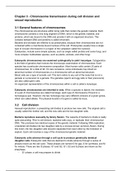Chapter 3 - Chromosome transmission during cell division and
sexual reproduction.
3.1 General features of chromosomes
The chromosomes are structures within living cells that contain the genetic material. Each
chromosome contains a very long segment of DNA, which is the genetic material, and
proteins, which are bound to the DNA and provide it with an organized structure. This
complex between DNA and proteins is called chromatin.
Bacteria and archaea are referred to as prokaryotes, because their chromosomes are not
contained within a membrane-bound nucleus of the cell. Prokaryotes usually have a single
type of circular chromosome in a region of the cytoplasm called the nucleoid.
Eukaryotes, include some simple species, such as single celled protists and some fungi, and
more complex multicellular species, such as plants, animals, and other fungi.
Eukaryotic chromosomes are examined cytologically to yield karyotype. Cytogenetics
is the field of genetics that involves the microscopic examination of chromosomes. Each
species has a particular chromosome composition. Most human cells contain 23 pairs of
chromosomes, for a total of 46. On rare occasions, some individuals may inherit an
abnormal number of chromosomes or a chromosome with an abnormal structure.
Blood cells are a type of somatic cell. This term refers to any cell of the body that is not a
gamete or a precursor to a gamete. The gametes (sperm and egg cells or their precursors)
are also called germ cells.
An organized representation of the chromosomes within a cell is called a karyotype.
Eukaryotic chromosomes are inherited in sets. When a species is diploid, the members
of a pair of chromosomes are called homologs; each type of chromosome if found in a
homologous pair. However, the two homologs may carry different versions of a given genes,
which are called alleles. The physical location of a gene is called its locus.
3.2 Cell division
Asexual reproduction: a preexisting cell divides to produce two new cells. The original cell is
usually called the mother cell, and the new cells are the two daughter cells.
Bacteria reproduce asexually by binary fission. The capacity of bacteria to divide is really
quite astounding. Prior to cell division, bacterial cells copy, or replicate, their chromosomal
DNA. This produces two identical copies of the genetic material. Following DNA replication,
a bacterial cell divides into two daughter cells by a process known as binary fission. During
this event, the two daughter cells become separated from each other by the formation of
septum. Each cell receives a copy of the chromosomal genetic material.
Eukaryotic cells advance through a cell cycle to produce genetically identical
daughter cells. Eukaryotic cells that are destined to divide advance through a series of
phases known as the cell cycle. These phases are named G for gap, S for synthesis, and M
for mitosis. There are two G phases: G1 and G2. G1, G2 and S phase are known as the
interphase.
- G1 phase: a cell may prepare to divide
sexual reproduction.
3.1 General features of chromosomes
The chromosomes are structures within living cells that contain the genetic material. Each
chromosome contains a very long segment of DNA, which is the genetic material, and
proteins, which are bound to the DNA and provide it with an organized structure. This
complex between DNA and proteins is called chromatin.
Bacteria and archaea are referred to as prokaryotes, because their chromosomes are not
contained within a membrane-bound nucleus of the cell. Prokaryotes usually have a single
type of circular chromosome in a region of the cytoplasm called the nucleoid.
Eukaryotes, include some simple species, such as single celled protists and some fungi, and
more complex multicellular species, such as plants, animals, and other fungi.
Eukaryotic chromosomes are examined cytologically to yield karyotype. Cytogenetics
is the field of genetics that involves the microscopic examination of chromosomes. Each
species has a particular chromosome composition. Most human cells contain 23 pairs of
chromosomes, for a total of 46. On rare occasions, some individuals may inherit an
abnormal number of chromosomes or a chromosome with an abnormal structure.
Blood cells are a type of somatic cell. This term refers to any cell of the body that is not a
gamete or a precursor to a gamete. The gametes (sperm and egg cells or their precursors)
are also called germ cells.
An organized representation of the chromosomes within a cell is called a karyotype.
Eukaryotic chromosomes are inherited in sets. When a species is diploid, the members
of a pair of chromosomes are called homologs; each type of chromosome if found in a
homologous pair. However, the two homologs may carry different versions of a given genes,
which are called alleles. The physical location of a gene is called its locus.
3.2 Cell division
Asexual reproduction: a preexisting cell divides to produce two new cells. The original cell is
usually called the mother cell, and the new cells are the two daughter cells.
Bacteria reproduce asexually by binary fission. The capacity of bacteria to divide is really
quite astounding. Prior to cell division, bacterial cells copy, or replicate, their chromosomal
DNA. This produces two identical copies of the genetic material. Following DNA replication,
a bacterial cell divides into two daughter cells by a process known as binary fission. During
this event, the two daughter cells become separated from each other by the formation of
septum. Each cell receives a copy of the chromosomal genetic material.
Eukaryotic cells advance through a cell cycle to produce genetically identical
daughter cells. Eukaryotic cells that are destined to divide advance through a series of
phases known as the cell cycle. These phases are named G for gap, S for synthesis, and M
for mitosis. There are two G phases: G1 and G2. G1, G2 and S phase are known as the
interphase.
- G1 phase: a cell may prepare to divide




